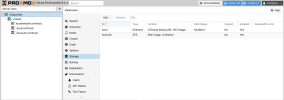I'm brand new to Proxmox. I just got a Nuc (today) with an i5-13500H CPU, 32gb ram ddr5 ram, 2X 2tb NVME. 2X2.5gb Nics. I will be running 3-4 VMs.
Thanks!
- opnSense (or Sophos) and Adguard Home
- Docker containers with the ARR stack, maybe Plex in docker if it will work with hardware acceleration, various other server containers
- Home Assistant
- If I havent bogged down my server, I'd like to play around with a windows VM (see what I can do with Blue Iris?). Experimental at this point.
- Do you forsee any performance issues with using ZFS given the ram to NVME ratio and VM useage pattern?
- Can I/Should I use the same NVME drives for downloads as I am for my root/and VMs (trying to save some money, and I only have the 2 NVME slots. I could only use a USB adapter for more space if that will be efficent and help). If I can use the 2x2gb NVMEs, I want to set it up so the downloads arent mirrored (dont want to add increased wear on the drives for something that is just temporary. If possible, how can this be done? My thought was in initial setup of Proxmox to not allocate 500gb to proxmox, leaving approximately 1.3gb of free space for proxmox root and VMs. Is that how it works? Does it partition my hard drive? Is that going to add complexity/undo maintenance headaches? Is there a different way to accomplish not mirroring a portion of those drives?
- Any thoughts on CPU and initial ram allocation for the VMs listed above. I'm most concerned about optimizing items 1-3 in my VM list. If I cant make 4 work, not an issue.
Thanks!



